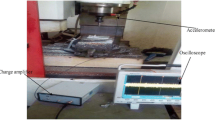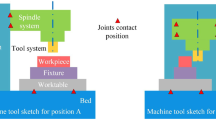Abstract
A cutter with inserts is suitably applied in screw rotor milling. However, the cutter design process, including arranging the inserts onto the cutter body accurately, involves numerous factors, so it is costly and lengthy to achieve a precise cutter design if performed by trial error. This study introduces an integrated optimization to simplify the cutter designing process by minimizing multi-objective factors (number of inserts, grinding stock amount, and rotor profile deviation), respecting four critical design factors (grinding allowance, insert arrangement area, insert inclination angle, and correctional offset). The uniform design was applied to obtain uniformity and representativeness in the experiment sample size, whereas radial basis function (RBF) approximated the design factors, and particle swarm optimization (PSO) predicted the optimum results. The result confirms that all objective factors were diminished significantly where the grinding allowance is the most influential factor. In addition, the rotor surface topography indicated a consistent deviation. Finally, the optimized cutter is reliable, and the integrated optimization model is effective and entirely practicable.















Similar content being viewed by others
Data availability
All data generated or analyzed during this study are included in the manuscript.
Code availability
Not applicable.
Abbreviations
- \(A_{3}\) :
-
Correctional offset of insert position on the cutter wheel
- \(E_{d}\) :
-
Shortest center distance among cutter wheel and rotor axis
- \(L_{d}\) :
-
Rotor length with respect to rotor rotational angle
- \(R_{4}\) :
-
Radial offset of insert position on the cutter wheel
- \(s_{p}\) :
-
Helical parameter / rotor unit lead
- \(S\) :
-
Rotational speed
- \(t\) :
-
Insert thickness
- \(u\) :
-
Fitted curve parameter (rotors profile parameter)
- \(Z_{4}\) :
-
Axial offset of insert position on the cutter wheel
- \(\alpha\) :
-
Index angle of insert position on the cutter wheel
- \(\beta\) :
-
Rotational angle of insert position on the cutter wheel
- \(\delta_{q}\) :
-
Normal deviation
- \(\gamma\) :
-
Setting angle of the cutter wheel and rotor axis
- \(\lambda\) :
-
Inclination angle of insert position on the cutter wheel
- \(\eta\) :
-
Enlargement
- \(\theta\) :
-
Surface variables
- \(\sigma\) :
-
Insert curve parameter
- \(\varphi\) :
-
Rotational angle
- c :
-
Milling cutter
- r :
-
Screw rotor
References
Engin S, Altintas Y (2001) Mechanics and dynamics of general milling cutters. Part II: inserted cutters. Int J Machine Tools and Manuf 41(15):2213–2231. https://doi.org/10.1016/S0890-6955(01)00046-3
Chiang CJ, Fong ZH (2010) Design of form milling cutters with multiple inserts for screw rotors. Mech Mach Theory 45(11):1613–1627. https://doi.org/10.1016/j.mechmachtheory.2010.06.012
Gilles PF, Monies F, Rubio W (2007) Optimum orientation of a torus milling cutter: method to balance the transversal cutting force. Int J Mach Tools Manuf 47(15):2263–2272. https://doi.org/10.1016/j.ijmachtools.2007.06.003
Arifin A, Wu YR (2022) Analytical design of disk-type milling cutter with multiple inserts and CNC milling simulation of screw rotors considering grinding stock. Mech Mach Theory. https://doi.org/10.1016/j.mechmachtheory.2022.104724
Gong X, Feng HY (2016) Cutter-workpiece engagement determination for general milling using triangle mesh modeling. Journal of Computational Design and Engineering 3:151–160. https://doi.org/10.1016/j.jcde.2015.12.001
Lotfi S, Rami B, Maher B, Giles D, Wassila B (2019) Cutter-workpiece engagement calculation in 3-axis ball end milling considering cutter runout. J Manuf Process 41:74–82. https://doi.org/10.1016/j.jmapro.2019.03.025
Jia K, Guo J, Zheng S, Hong J (2019) A general mathematical model for two-parameter generating machining of involute cylindrical gears. Appl Math Model 75:37–51. https://doi.org/10.1016/j.apm.2019.05.021
He K, Li G, Du Y, Tang Y (2019) A digital method for calculation the forming cutter profile in machining helical surface. Int J Mech Sci 155:370–380. https://doi.org/10.1016/j.ijmecsci.2019.03.018
Tang Q, Zhang Y, Jiang Z, Yan D (2015) Design method for screw forming cutter based on tooth profile composed of discrete points. J Mech Des 137(8):1–8. https://doi.org/10.1115/1.4030648
Shen Z, Yao B, Teng W, Feng W, Sun W (2016) Generating grinding profile between screw rotor and forming tool by digital graphic scanning (DGS) method. Int J Precis Eng Manuf 17(1):35–41. https://doi.org/10.1007/s12541-016-0005-0
Kuang Y, Lin W, Dong Z, Wu L, Wang Q (2020) A cutter path generation strategy for helical surface machining of screw rotor. Sci Prog 103(1):1–16. https://doi.org/10.1177/0036850419882180
Han J, Yuan B, Wang D, Sun D, Xia L (2017) Formation mechanism study on tooth surface of two gear finishing processes: combined theoretical and experimental approaches. J Braz Soc Mech Sci Eng 39(12):5159–5170. https://doi.org/10.1007/s40430-017-0872-z
Torta M, Albertelli P, Monno M (2020) Surface morphology prediction model for milling operations. The International Journal of Advanced Manufacturing Technology 106(7–8):3189–3201. https://doi.org/10.1007/s00170-019-04687-x
Wang P, Zhang S, Li Z, Li J (2016) Tool path planning and milling surface simulation for vehicle rear bumper mold. Adv Mech Eng 8(3):1–10. https://doi.org/10.1177/1687814016641569
Hoang MT, Wu YR, Tran VQ (2020) A general mathematical model for screw-rotor honing using an internal-meshing honing machine. Mech Mach Theory 154:1–15. https://doi.org/10.1016/j.mechmachtheory.2020.104038
Fang KT (2002) Theory, method and applications of the uniform design. International Journal of Realiability, Quality and Safety Engineering 9(4):305–315. https://doi.org/10.1142/S0218539302000858
Li R (2002) Model selection for analysis of Uniform Design and computer experiment. International Journal of Realiability, Quality and Safety Engineering 9(4):367–382. https://doi.org/10.1142/S0218539302000901
Xie K, Huang Y, Hu B, Tai HM, Wang L, Liao Q (2020) Reliability evaluation of bulk power systems using the uniform design technique. IET Gener Transm Distrib 14(3):400–407. https://doi.org/10.1049/iet-gtd.2018.6040
Kitayama S, Arakawa M, Yamazaki K (2011) Sequential approximate optimization using radial basis function network for engineering optimization. Optim Eng 12(4):535–557. https://doi.org/10.1007/s11081-010-9118-y
Kitayama S, Srisat J, Arakawa M, Yamazaki K (2015) Sequential approximate multi-objective optimization using radial basis function network. Struct Multidiscip Optim 48(3):501–515. https://doi.org/10.1007/s00158-013-0911-z
Aghbashlo M, Hosseinpour S, Tabatabaei M, Dadak A, Younesi H, Najafpour G (2016) Multi-objective exergetic optimization of continuous photo-biohydrogen production process using a novel hybrid fuzzy clustering-ranking approach coupled with Radial Basis Function (RBF) neural network. Int J Hydrogen Energy 41:18418–18430. https://doi.org/10.1016/j.ijhydene.2016.08.123
Zhang N, Shi Y (2019) Improvement of cutting force and material removal rate for disc milling TC17 blisk tunnels using GRA–RBF–PSO method. Proceedings of the Institution of Mechanical Engineers, Part C: Journal Mechanical Engineering Science 233(16):5556–5567. https://doi.org/10.1177/0954406219848473
Hsieh HT, Chu CH (2012) Optimization of tool path planning in 5-axis flank milling of ruled surfaces with improved PSO. Int J Precis Eng Manuf 13(1):77–84. https://doi.org/10.1007/s12541-012-0011-9
Zhou JH, Ren JX, Yao CF (2017) Multi-objective optimization of multi-axis ball-end milling Inconel 718 via grey relational analysis coupled with RBF neural network and PSO algorithm. Measurement 102:271–285. https://doi.org/10.1016/j.measurement.2017.01.057
Sibalija TV (2019) Particle swarm optimization in designing parameters of manufacturing processes: A review (2008–2018). Applied Soft Computing Journal 84:1–33. https://doi.org/10.1016/j.asoc.2019.105743
Theposonthi T, Ozel T (2012) Multi-objective process optimization for micro-end milling of Ti-6Al-4V titanium alloy. Int J Adv Manuf Technol 63:903–914. https://doi.org/10.1007/s00170-012-3980-z
Fang H, Rohani MR, Liu Z, Horstemeyer MF (2005) A comparative study of metamodeling methods for multiobjective crashworthiness optimization. Comput Struct 83:2121–2136. https://doi.org/10.1016/j.compstruc.2005.02.025
Acknowledgements
The authors are grateful to the Ministry of Science and Technology in Taiwan for its financial support under project number MOST 109-2221-E-008-004-MY2 and to Hanbell Precise Machinery Co., Ltd., in Taiwan for their technical and financial support.
Funding
This research was supported by the Ministry of Science and Technology in Taiwan, project number MOST 109–2221-E-008–004-MY2.
Author information
Authors and Affiliations
Contributions
Achmad Arifin constructed the research design, accomplished the optimization simulation, and composed the manuscript, whereas Yu-Ren Wu earned the funding and directed the research implementation. All authors worked concurrently to proofread and structure the submission.
Corresponding author
Ethics declarations
Ethics approval
Ethical standards are in place (no human participants or animals involved).
Consent to participate
Not applicable.
Consent for publication
All involved authors have read and consented to publish the manuscript.
Competing interests
The authors declare that they have no competing interests.
Additional information
Publisher's Note
Springer Nature remains neutral with regard to jurisdictional claims in published maps and institutional affiliations.
Rights and permissions
About this article
Cite this article
Arifin, A., Wu, YR. Integrated multi-objective optimization on the geometrical design of a disk-type milling cutter with multiple inserts applying uniform design, RBF neural network, and PSO algorithm. Int J Adv Manuf Technol 121, 4829–4846 (2022). https://doi.org/10.1007/s00170-022-09645-8
Received:
Accepted:
Published:
Issue Date:
DOI: https://doi.org/10.1007/s00170-022-09645-8




